Traditional Portuguese Christmas desserts (and where to try them in Lisbon)

Every country has its Christmas rituals, but Portugal might be one of the few places where the dessert table steals the show when compared to the main meal. The bacalhau might be the official star of Christmas Eve, and the roasted turkey might get the honor on Christmas Day, but everyone knows what people are really waiting for, and that is the moment when you get to finally “attack” the spread of sweets that often goes by the name of mesa dos doces. This literally translates as “dessert table” as, in many families, Christmas desserts are indeed displayed on a separate table, as there’s just so much to choose from that normally there’s not enough room for it all on the main table where the family sits. We’re talking about a large variety of golden fritters, creamy puddings, pastries coated in sugar and cinnamon, dried fruits and other spiced cakes that are often left out not only to enjoy as dessert on Christmas Eve and Christmas Day itself, but also to enjoy for breakfast and snack on during the days after.
There’s a reason Portugal takes sweet things seriously, especially in December. Just a few centuries ago, sugar was a luxury reserved for special occasions. In the convents scattered through the country, nuns perfected the art of transforming egg yolks, the leftover byproduct of starching laundry, into the doces conventuais that still define Portuguese pastry today. Add to that the long influence of Arab culinary knowledge in Portugal, the abundance of almonds in the south, the Atlantic trade routes that flooded the country with spices, molasses and dried fruits, and you have the foundations of a Christmas table that brings together several centuries of history, trade and family tradition.
But beyond the big classics you’ll find in pastry shops, supermarkets and December markets, there’s another layer to the Portuguese Christmas sweet scene that is more regional. Many of the sweets Portuguese families enjoy during the holidays are family recipes, and rarely make it outside of the home kitchen. Think about the grandmother in Trás-os-Montes with her own version of formigos. The Alentejo auntie who fries filhós the size of dinner plates every 24th of December. The Madeiran cousin who insists that her broas de mel need at least a month to rest before they’re worthy of the family table. To taste some of these wonderful recipes, you’d have to be lucky enough to be invited into someone’s home. As for the other sweet options, we suggest below where you can sample them in the very heart of Lisbon.
What follows is a tour of Portugal’s most beloved Christmas sweets, the ones that have earned their place on many tables across the country.
Feat photo by Pastelaria Batalha
Bolo-rei

Photo by Confeitaria Nacional
No Portuguese Christmas table feels complete without a bolo-rei, the round, crown-shaped cake with candied fruit, nuts and raisins. Even people who claim they “don’t like it” will still have an opinion about where to buy the best one, because bolo-rei is less a dessert and more a seasonal ritual. This colorful cake has been part of Portuguese holiday imagery for well over a century, though its roots are surprisingly foreign.
Bolo-rei only arrived in Portugal in the late 1800s, when the Lisbon bakery Confeitaria Nacional introduced a recipe inspired by the French gâteau des rois. At the time, Lisbon’s bourgeoisie was eager to adopt anything Parisian, from fashion to pastry, and bolo-rei quickly became synonymous with sophistication. Besides being a sweet treat, bolo-rei introduced a little ritual that many of us have partaken in since childhood. Inside the dough, the cake would include a hidden fava bean and, until a few decades ago, also a small toy. Whoever found the fava had to buy next year’s bolo-rei and, whoever got the prize, was considered lucky. This tradition faded in the 21st Century due to food safety regulations, but older generations still smile when they talk about the time they almost broke a tooth on a metal soldier or a porcelain charm.
Despite its French origins, bolo-rei absorbed Portuguese tastes. Bakers adapted it to local ingredients and flavor preferences, using more nuts, more raisins, and a generous amount of Port wine or brandy to make the dough more aromatic. Over time, regional variations started emerging. The most famous one is bolo-rei escangalhado, a specialty of the Sintra area. Instead of the neat crown shape, this is a glorious “messy king cake” folded around strands of eggy fios de ovos and filled with dried fruits. It’s richer, stickier, and indulgent enough that many families prefer it to the traditional version, especially those who don’t care all that much for candied fruit.
While bolo-rei was originally tied to Dia de Reis (Epiphany, on January 6), in modern Portugal it appears as soon as December begins. It’s the cake you bring to the office (or sometimes that your employer may gift for you to bring back home to enjoy with the family), the one you share with friends, and the one you nibble on whether it’s fresh or, as many would actually defend tastes even better, sliced and toasted with a generous spread of butter – if you feel like treating yourself to a very Portuguese breakfast on Christmas morning, this would be the way to go!
Where to buy the best bolo-rei in Lisbon:
Confeitaria Nacional
They still make the classic version with the prestige of being the bakery that first introduced this cake to Portugal (pictured above).
📍Praça da Figueira 18B, 1100-241 Lisbon
https://confeitarianacional.com
Bolo-rainha

Photo by Inês Gomes Lourenço via NIT
If bolo-rei is the traditional monarch of the Portuguese Christmas table, then bolo-rainha is the queen who quietly stole the throne. Created as a variation for those who can’t stand candied fruit, bolo-rainha keeps the spirit of the classic king cake but swaps the colorful sugary fruits for a generous load of nuts. Even though bolo-rainha feels somewhat humbler in appearance, as it doesn’t look as “royal” as bolo-rei, it is actually more expensive because of the generous use of nuts.
Bakeries began offering bolo-rainha widely only in the late 20th century, marketing it explicitly as the alternative for those who loved the texture of bolo-rei but not the candied fruits. It has the exact same enriched dough used for bolo-rei, but crowned only with almonds, walnuts, pine nuts and sometimes hazelnuts. Inside, the dough is left cleaner and more buttery, occasionally enriched with raisins or sultanas but avoiding the sticky candied pieces entirely. The result is a cake that feels more delicate and balanced, less showy but actually more crowd-pleasing. In many families, bolo-rainha now outsells the original bolo-rei, but this is a debate we suggest you engage in if you make any local friends about the holiday season.
Where to taste bolo-rainha in Lisbon:
Gleba
There’s bolo-rei and bolo-rainha in practically every pastry shop and even supermarket in Portugal around Christmas time. For an insanely delicious bolo-rainha we would recommend Gleba, which makes a sourdough version which is naturally leavened making the dough even more delicate. It’s enriched with lots of dried fruits, as well as candied orange peel, figs and raisins macerated in Port wine and Bourbon vanilla.
📍Several stores around Lisbon:
https://mygleba.com
Rabanadas (aka fatias douradas)
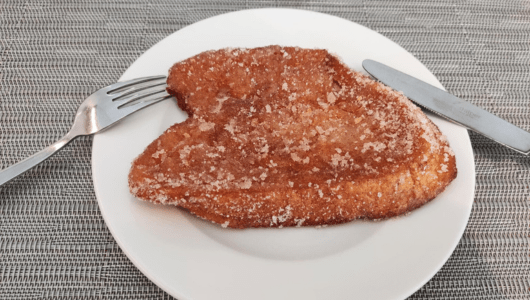
Photo by NIT
If there is one Christmas sweet that every Portuguese family prepares in its own particular way, that is rabanadas. Often described as the Portuguese version of French toast, we’d like to defend that they’re more diverse than just that. In essence, rabanadas are slices of bread soaked, fried and coated with something sweet. But that basic description doesn’t truly cover all the regional varieties you can find across Portugal.
The origins of rabanadas date back to times when nothing in the kitchen went to waste. It’s one of the best recipes you can prepare with old bread, actually turning it into something very indulgent, perfect for the Christmas table, something which you find here in Portugal but also in Spain as torrijas, and in France as pain perdu.
In the north of Portugal, especially in Minho and Douro, rabanadas can be dipped in a mix of milk and egg yolk just like elsewhere, or, surprisingly to some, they can also be soaked with red vinho verde wine, sugar and cinnamon (rabanadas de vinho). The wine gives them a rosy tint and a subtle acidity that cuts through the sweetness, and while they may appear rustic in appearance, we honestly think there’s a certain sophistication to this dessert. This version is usually drizzled with syrup (calda) made from water, sugar, cinnamon and lemon peel, something that can also be used to take the traditional milky ones to the next level.
In the Beiras and Ribatejo regions, rabanadas are more standard, even though here they are often called fatias douradas. They are soaked in a mixture of milk and egg before being fried until golden, which explains the name fatias douradas, that is, golden slices. Some add a splash of brandy or a strip of lemon zest to the milk for extra flavor. After frying, the slices are dusted generously with cinnamon sugar or bathed in a light syrup infused with citrus.
In Porto, another popular variation appears: rabanadas em vinho do Porto. As the name promises, bread slices are soaked in Port wine before being fried and served with a thick syrup made from the same fortified wine. These are decadent, boozy and extra festive!
Rabanadas are usually made on the afternoon of December 24, filling the house with the warm smell of frying, sugar and cinnamon. Unlike French toast at a brunch cafe, rabanadas are customarily eaten cold, not just on that day itself for dessert, but on Christmas itself, for breakfast or any other time of the day. Even cold, as they are soaked in syrup or coated in a sugar that has become moist after some hours, they are still irresistible.
Where to eat rabanadas in Lisbon:
Pastelaria Querubim
Traditional pastry shops and even restaurants will serve rabanadas during December, namely the milky version. For a good home-style rabanada, we suggest Querubim in the non-touristy neighborhood of Telheiras.
📍Alameda Q.ta de Santo António, 1600-675 Lisbon
Sonhos

Photo by VortexMag
Sonhos are one of the most poetic names in the Portuguese Christmas universe, as this sweet’s name literally translates as “dreams”. Despite their simplicity, these deep-fried dough puffs are one of the most beloved holiday sweets in the country.
The classic sonho is made from a dough similar to choux pastry, prepared with eggs, flour, and sometimes a little citrus zest. When dropped into hot oil, the dough puffs up becoming super airy inside. They’re traditionally rolled in sugar and cinnamon, although some households leave them plain and serve them with a light syrup of sugar, lemon and cinnamon.
As it happens with other Christmas fritters, there are many versions of sonhos depending on the family who’s preparing them. One of the most iconic variations is sonhos de abóbora, made with pumpkin purée mixed into the dough. Popular especially in the north and central regions, they are moister and denser than the classic version. These pumpkin sonhos are often seasoned with orange zest, nutmeg or a hint of anise, making them smell stereotypically like the holidays. There are also sonhos de cenoura, common mostly in parts of the Alentejo and Algarve. The carrot gives them a delicate orange color and a natural sweetness, making these some of the softest and most tender sonhos you’ll find. Those who like citrus will enjoy sonhos de laranja, with orange zest giving a touch of freshness to the dough.
Regardless of their flavor profile, sonhos are almost always made on Christmas Eve. The frying itself is a ritual, while someone mixes the dough, someone else stands guard by the pot, and the rest of the family “tests” the first batch in the name of quality control.
Where to eat some dreamy sonhos in Lisbon:
Confeitaria Cistér
This bakery and pastry shop has been open since 1838 so, as you can imagine, they’ve had enough time to perfect all the usual cakes and pastries you normally find at Portuguese pastelarias. Just before December rolls in, their counters fill in with Christmas specialities, including fluffy sonhos.
📍Rua da Escola Politécnica 107, 1200-424 Lisbon
www.instagram.com/confeitariacister
Filhós (or filhoses)
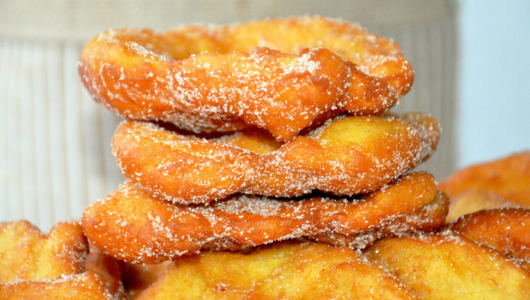
Photo by NIT
By now it has become quite clear that some of the most beloved Portuguese Christmas desserts are essentially a form of sugary fried dough, and filhós, sometimes also referred to as filhoses, is no exception. These golden, fried pastries are among the oldest and most widespread Christmas treats in the country, even though their preparation can vary widely by geography and family tradition.
Filhoses are made from a yeasted dough prepared with flour, eggs, a little sugar, and a good amount of citrus zest and, optionally, aguardente, which is a strong alcohol distilled from grapes. The dough is kneaded, left to rise, hand-stretched into a rustic shape, and fried until blistered and crisp. Once golden, they’re dusted with sugar and cinnamon or brushed with a light syrup.
In some households, filhós are traditionally large, rolled thin and stretched until they become an irregular circle with delicate edges. Sometimes, the dough can even be prepared with olive oil instead of butter or margarine, resulting in something between a fluffy fritter and a crisp pastry. In some other kitchens, you’ll find thicker, fluffier versions, often slightly chewy in the center. These are usually flavored with orange zest or brandy, sometimes both. Some families soak them briefly in a syrup of sugar and lemon, giving them a glossy finish that keeps them moist for days.
There’s also the less rustic (at least in terms of looks), filhoses de forma. These delicate, lacy pastries are made using decorative iron molds, which often come in the shape of stars, flowers or snowflakes. The molds are heated in oil, dipped in a thin batter, and plunged back into the hot oil to release crisp, sculpted cookies. They’re lighter, crunchier, and far more delicate than the yeast based versions.
Where to sample filhoses in Lisbon:
Confeitaria Versailles
Many traditional neighborhood pastelarias produce the fluffy versions of filhoses, while only certain confectioneries and holiday markets sell filhós de forma. The classic pastry shop Versailles in central Lisbon is always a safe bet for anything Christmas sweet related!
📍A few stores in different parts of Lisbon:
Coscorões
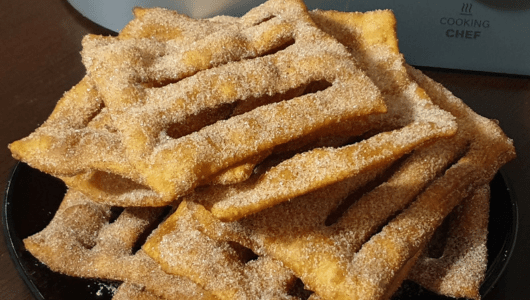
Photo by Uma Receita Vou Contar…
These thin sheets of dough, stretched, cut, and fried until they blister into crisp, golden pieces, are one of Portugal’s most traditional festive fritters. They’re simple, rustic, and incredibly satisfying, especially when eaten warm and dusted generously with sugar and cinnamon.
Unlike filhoses, which tend to puff and soften, coscorões are all about crunch. The dough is made with flour, eggs and a bit of fat (oil or butter), brought together with citrus zest and brandy (aguardente) for fragrance. Once rested, it’s rolled out into thin rectangles or diamonds and cut with small slits that expand beautifully when fried.
Coscorões are among the oldest recorded Portuguese Christmas sweets, with roots that stretch back to pre-convent times. Regional touches give them distinct personalities. In the north, especially Minho and Douro, the dough often carries more citrus zest, making the fritters bright and aromatic. While in Beiras and Ribatejo, the dough might be slightly thicker and flavored with brandy or anise, giving them a warmer, deeper aroma.
What makes coscorões so quintessentially Portuguese is how they bridge simplicity and celebration. They are cheap to make, entirely based on pantry ingredients, and yet they feel festive the moment they hit the sugar bowl. People make them by the dozens, trays piled high, ready to last beyond Christmas Eve, but they rarely survive that long.
Feel like trying coscorões in Lisbon? It’s simple:
Coscorões start showing up in Lisbon’s pastry shops as early as the first week of December. Traditional bakeries that specialize in holiday fritters often fry them fresh each morning, selling them still slightly warm – this is honestly how to enjoy them best, as cold they are still tasty and crunchy, but nothing beats them freshly fried with a nice hot beverage. Luckily, you don’t have to go to any specialized shop, as you’ll find coscorões in most pastry shops and even supermarkets around Lisbon.
Broas castelares
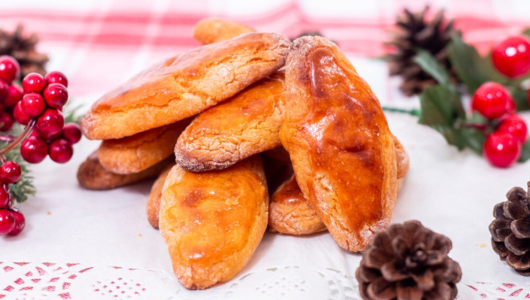
Photo by O Careca
You don’t need a calendar to know Christmas is approaching in Lisbon as the city’s pastry shops will tell you. As soon as trays of broas castelares appear behind glass counters, golden and slightly cracked on top, you know December has officially begun. These are some of the most emblematic Christmas treats in the capital, and unlike many other festive sweets that travel across regions, broas castelares are unmistakably tied to Lisbon’s confectionery tradition.
Their origins go back to the 19th century and are connected with convent sweets traditions. Back then, Lisbon’s nuns mastered the art of combining sweet potato, a cheap and abundant ingredient, with sugar, eggs and ground almonds. The mix created a dense, fragrant dough, perfumed with spices like cinnamon or clove, that could be shaped into small oval cakes, brushed with egg yolk, and baked until glossy and super aromatic. They earned prestige quickly, becoming a specialty sold at Christmas fairs, street stalls, and the bakeries of the capital.
Variations exist, though mostly within Lisbon and its surrounding towns. Some bakers add a little honey, others enrich the dough with orange zest or a touch of fennel. Texture also varies, as some are soft and cakey inside, while others are slightly firmer with a texture closer to a cookie. They keep well for days, and they often show up on the Christmas table alongside the more fragile fritters that must be eaten within a couple of days.
Buy broas castelares in Lisbon at:
Pastelaria O Careca
Even though this pastry shop in Restelo has become synonymous with sugary croissants, they also make surprisingly good broas castelares during the holiday season.
📍Rua Duarte Pacheco Pereira 11D, 1440-139 Lisbon
Azevias

Photo by Ruralea
Azevias are half-moon pastries featuring thin dough on the outside, and a smooth sweet filling on the inside. They are one of the clearest surviving links between the long Arab presence in the Iberian Peninsula and Portugal’s festive table. They are typical from the south of the country, something which becomes quite evident when looking at the main ingredients used to make them, which include chickpeas or sweet root vegetables mashed with sugar, cinnamon, citrus and sometimes almonds, wrapped in dough and fried.
The most traditional and widespread kind is azevias de grão, filled with a silky paste of cooked chickpeas mashed with sugar, cinnamon, lemon zest and sometimes a touch of Port wine. They have a delicate, slightly nutty sweetness and a creamy texture that surprises anyone who doesn’t expect chickpeas in dessert form. Equally popular, and beloved in the Algarve and parts of the Alentejo, are azevias de batata doce. These use sweet potato as the base of the filling, resulting in a smoother, sweeter paste that pairs beautifully with orange zest and cinnamon. The flavor is gentle and comforting, often lighter than the chickpea version. Then there are azevias de amêndoa, the richest of the trio. Almonds, long cultivated in the south, appear in many Christmas sweets, and in this version they’re ground and cooked with sugar, lemon, and sometimes a bit of egg to create a paste that resembles soft marzipan. These azevias are denser and somewhat more luxurious, but also less common than the varieties above.
All types share the same technique, featuring a thin dough envelope, traditionally made with flour, water, a little fat (back in the day it could be lard but, these days, butter or margarine are more common), and citrus zest. The dough is rolled out, filled, folded into a crescent, sealed, and fried until golden and crunchy. Once out of the oil, they’re rolled in sugar and cinnamon because at Christmas, almost no Portuguese sweet fritter can escape this crucial step.
You don’t need to travel to the south of Portugal to eat authentic azevias. Here in Lisbon you can try them at:
Xandite
We love the Lisbon neighborhood of Campo de Ourique, as we feel it has a great mix of traditional and modern vibes. Head to Pastelaria Xandite for a wonderful spread of Christmas fritters, including incredible chickpea azevias.
📍Rua Tomás da Anunciação 51A, 1350-166 Lisbon
Lampreia de ovos
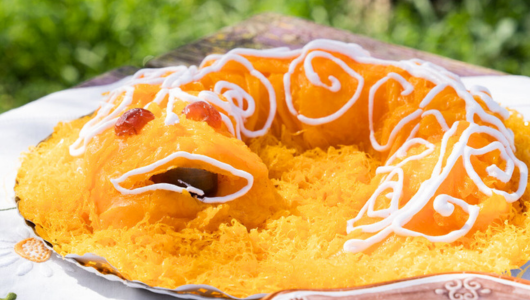
Photo by VisitChamusca
Nothing prepares you for your first encounter with lampreia de ovos. It’s one of those Christmas sweets that makes you stop, blink twice, and ask yourself whether you’re looking at dessert or an art project that went slightly off the rails. Bright yellow and shaped like the river creature it’s meant to imitate, this is for sure the most visually dramatic dessert on the Portuguese Christmas table.
And let’s be honest: even in the best pastry shops, lampreias de ovos can sometimes wander into “expectation vs. reality” territory. The original versions can of course be elegant and almost sculptural. But many homemade lampreias, and a few brave but maybe a little overconfident bakery ones, look more like the viral cooking fails where someone posts the flawless inspiration photo next to their very own mildly terrifying creation. Between the peculiar fish shape and the fact that it’s all molded by hand, the results can range from funny and adorable, to “someone please put that thing back in the river”.
Once you get past its peculiar looks, it’s interesting to point out that this dessert is pure doçaria conventual, built almost entirely from egg yolks and sugar, the queen and king of Portugal’s pastry heritage. The choice of shaping it like a lamprey isn’t random either. Ribatejo, the birthplace of lampreia de ovos, has a long association with the Tagus River and its fish, and convents often created sweets inspired by local symbolism. In a way, crafting a lamprey out of sugared yolks was a tribute to the surrounding landscape, and perhaps also a way for cloistered nuns to express creativity in an era with very limited artistic outlets.
The preparation involves the use of a thick paste of egg yolks, sugar and sometimes lemon zest, cooked slowly until it becomes moldable. Once cooled to the perfect temperature, the paste is shaped by hand into a coiled fish, decorated with almonds and candied fruit, and often glazed with more yolk for that shiny finish. Some chefs fold in strands of fios de ovos, adding texture and indulgence. The result is very rich and sweet, so we’d recommend going for small portions.
If you’re not intimidated by its looks, go fish a lampreia de ovos in Lisbon at:
Pastelaria Benard
Just like all of the other sweets we’ve explored above, lampreia de ovos is common both in Lisbon’s pastry shops as well as supermarkets. To try an eccentric but delightful version of this sweet, we’d recommend the central Pastelaria Benard, in the heart of Baixa-Chiado district.
📍Rua Garrett 104, 1200-205 Lisbon
Aletria
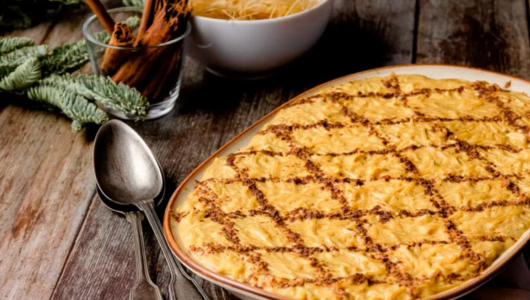
Photo by NCultura
Creamy, sweet and perfumed with cinnamon, aletria is a vermicelli pudding that makes appearances on the Portuguese table during Christmas, but can also show up during other religious celebrations like Easter or family gatherings like Sunday lunches.
The origins of aletria are connected with the long Arab presence in the Iberian Peninsula. The very word “aletria” is connected to the Arabic al-irtiyya, referring to thin strands of pasta. Vermicelli puddings sweetened with milk and sugar have cousins across North Africa, the Middle East, Turkey and parts of India. Portugal adopted the concept early, and convent kitchens refined it into the dessert we know today, rich with egg yolks and scented with cinnamon, trademarks of Portugal’s doçaria conventual.
But while its roots are ancient, the way aletria is made today varies depending on where you are. In the north of Portugal, especially in Minho and Porto, aletria is typically firm. The noodles are cooked slowly in milk, sugar and lemon peel, then enriched with egg yolks until the mixture thickens enough to slice. Once it cools, it sets like a soft cake. Families decorate the top with cinnamon in symmetrical lines or geometric patterns. In the center and south of the country, you’re more likely to find a creamier version, which is spoonable, silky and more similar to the usual consistency of rice pudding (see below). This is a humble dessert that, unlike things like lampreia de ovos, most families would make at home rather than purchase.
Try to make your own aletria with our recipe:
Finding aletria in shops around Lisbon is not impossible, but it’s certainly not easy. So we hope you accept our challenge to make a creamy and easy version of this delicious dessert at home:
Quick aletria recipe (serves 4)
Ingredients:
– 250 g vermicelli (aletria)
– 2 lemon peels
– 1 cinnamon stick
– 1 tsp butter (50 g)
– 200 g sugar
– 500 ml water
– 500 ml milk
– 2 egg yolks
– A pinch of salt
Instructions:
- In a pot, bring to a boil the water, milk, butter, salt, sugar, lemon peels and cinnamon stick.
- Add the broken vermicelli and cook for about 3 to 4 minutes.
- Remove from heat, quickly stir in the egg yolks so they blend without curdling.
- Return to low heat for 1 more minute, stirring constantly.
- Pour into bowls and dust with cinnamon.
Arroz doce
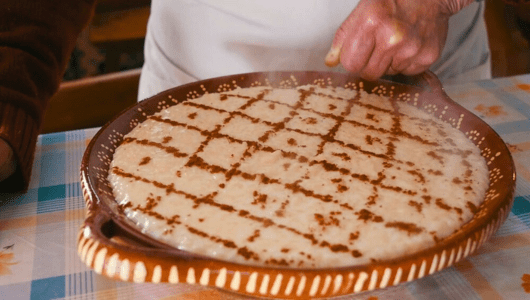
Photo by Notícias de Coimbra
Aletria certainly is a popular Portuguese Christmas pudding, but arroz doce is the one with the biggest fan club. Creamy, comforting and with the aromas of lemon and cinnamon, this rice pudding is eaten all year round, but at Christmas it becomes an essential element of the dessert table.
Similarly with aletria, rice arrived in Portugal through centuries of contact with the Islamic world, and rice puddings sweetened with milk are found across the Middle East, North Africa, India and the Mediterranean. Portuguese convents embraced the dish early, enriching it with egg yolks (as they did with everything), and developing a version that sits somewhere between the Moorish tradition of milk puddings and the Catholic fondness for desserts rich in egg yolks.
The final texture of arroz doce varies depending on the cook, but we like the ultra creamy version in which the rice is cooked slowly until the grains almost melt into the milk, becoming super silky. Just like aletria, arroz doce is topped with cinnamon, whether it is a simple dusting of more complex geometric grids, crosses or other even more creative approaches.
One thing is for sure, and that is that arroz doce is one of the most democratic desserts on the table. It doesn’t require expensive ingredients, it feeds a crowd, and it’s almost universally adored. It’s also the Christmas sweet that crosses more cultural boundaries, appearing in every region, alongside other ultra popular options like rabanadas, sonhos and filhoses.
Don’t wait until Christmas! Eat arroz doce in Lisbon all year long at:
Adega da Tia Matilde
Lisbon is an excellent place to taste arroz doce, as many restaurants serve it all year long. This elegant but traditional restaurant, open since the 70s, makes a genuine version which is the closest to a grandma type of recipe you are likely to taste at a commercial establishment here in the city.
📍Rua da Beneficência 77, 1600-017 Lisbon
www.instagram.com/adegadatiamatilde
Pão de ló

Photo by O Melhor Pão de Ló do Universo
Few Portuguese cakes have the same importance as pão de ló. Light, airy and deceptively simple, it’s one of those desserts that manages to show up at every celebration, like Easter, birthdays and Sunday lunches, but that at Christmas becomes something extra special. What looks like a modest sponge cake is, in fact, part of a much larger family tree that stretches across continents.
Its closest cousins are the European sponge cakes that emerged around the Renaissance, including the Italian pan di Spagna and the Spanish bizcocho, all born from the same essential formula of eggs, sugar and flour beaten until they triple in volume. But Portugal didn’t just inherit this tradition, as it also ended up exporting it. When Portuguese missionaries and merchants arrived in Japan in the 16th century, they brought pão de ló with them. The Japanese adapted it to local tastes and ingredients, and over time it became kasutera, now one of Japan’s most iconic cakes. Soft, bouncy and scented with honey, kasutera is still recognized today as a direct descendant of Portuguese pão de ló.
Back home, the cake evolved differently. Portugal embraced its convent baking heritage, which leaned heavily on egg-based desserts, which were the natural result of countless leftover yolks from starching laundry. Armed with nothing but eggs, sugar, flour and remarkable technique, bakers created regional versions that range from barely set and custardy to dry, fluffy and ideal for dipping.
The most famous is pão de ló de Ovar, with its molten center that oozes out the moment you cut it. Pão de ló de Alfeizerão is similarly runny, the result (so the legend says) of a fortunate baking “mistake”. Meanwhile, pão de ló de Margaride and other northern styles are lighter, drier and more like a sponge, perfect with coffee or a post Christmas lunch glass of Port. No matter the version, pão de ló is a deeply symbolic Portuguese Christmas sweet.
Why just eat a regular pão de ló, when you can eat The Best Sponge Cake in the Universe?
O Melhor Pão de Ló do Universo
This store’s name literally translates as “the best pão de ló in the universe”. Even though that is of course up for debate, it is nonetheless a great place to sample the Portuguese version of sponge cake, both in its traditionally runny center recipe (pictured here), as well as more contemporary versions like chocolate pão de ló.
📍Rua Nova de São Mamede 54, 1250-204 Lisbon
www.instagram.com/omelhorpaodelodouniverso
Mexidos (or formigos)
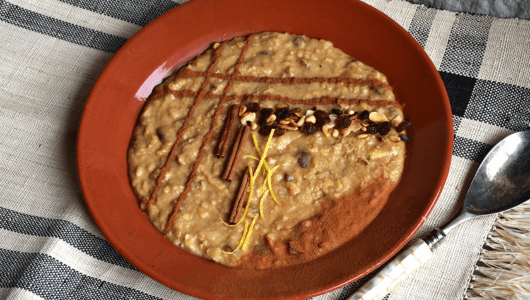
Photo by Deliciosa Paparoca
Mexidos, also known in many places as formigos, are a rustic northern dessert. It looks simple and perhaps even a little old-fashioned and, while it may not have the glamour of bolo-rei or the fun appeal of a lampreia de ovos, it’s an essential Christmas dessert for generations of families in the Minho, Trás-os-Montes and Beiras regions.
Historically, this was the sweet made in rural households when nothing could be wasted, making good use of stale bread, dried fruits gathered throughout the year, leftover honey, a bit of wine or aguardente, and whatever nuts the family had access to. This was all mixed together with butter, sugar and plenty of cinnamon, resulting in a fragrant and comforting dessert to be eaten by the spoonful.
The base is indeed very simple but, back in the day, using ingredients like raisins, pine nuts, walnuts or almonds, it was luxurious enough for the dish to be considered festive. In many places, they would also add a splash of Port wine or muscatel, for extra aroma.
The northern name formigos (“ants”) is usually explained by the raisins and nuts dotting the mixture like little dark specks. Mexidos (“stirred”) refers to the technique, as this is essentially a pot of slowly simmered ingredients stirred until everything melds together.
Today, mexidos rarely appear in Lisbon bakeries, precisely because they’re so tied to home cooking. Families who grew up in the north often prepare them from memory, with slight adjustments and improvisations, which means no two batches ever taste exactly the same. Some are wetter, some drier, some more fragrant, some loaded with nuts, but all of them taste like the kind of dessert only a grandma could make.
If you don’t have friends from Northern Portugal, to try formigos you’ll probably have to get busy in your own kitchen.
Formigos / mexidos recipe (serves 4)
Ingredients:
– 200 g sugar
– 650 ml water
– 50 g honey
– 50 g unsalted butter
– 2 cinnamon sticks
– 3 strips of lemon peel (yellow part only)
– 250 g white bread, crumbled by hand
– 2 tbsp Port wine
– 50 g pine nuts
– 50 g walnuts
– 25 g raisins
– 2 egg yolks
– Ground cinnamon, for dusting
Instructions:
- In a saucepan, heat the sugar, water, honey, butter, cinnamon sticks and lemon peel until it comes to a boil.
- Add the crumbled bread and mix well.
- Reduce to low heat and cook for 5 minutes, stirring occasionally.
- Add the Port wine, pine nuts, walnuts and raisins. Mix, then stir in the egg yolks.
- Cook for another 5 minutes, stirring so it doesn’t stick.
- Remove the cinnamon sticks and lemon peel, transfer to a serving dish and let cool. Dust with cinnamon before serving.
Broas de mel da Madeira
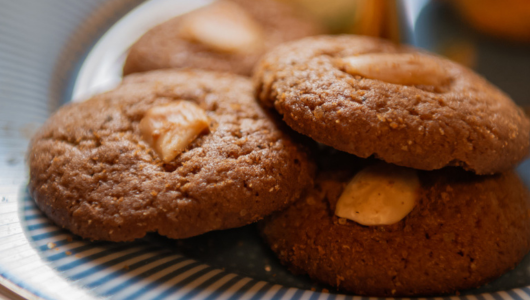
Photo by Visit Madeira
On the Portuguese island of Madeira, where sugarcane once made the region one of Europe’s most important sources of sweetness, Christmas time is time for broas de mel. Even though the name literally translates as “honey cakes”, when we talk about Madeira, “mel” usually refers to “mel de cana”, that is sugarcane molasses, and not bee honey.
Madeira’s relationship with sugar runs deep. By the 15th century, the island had vast sugarcane plantations that supplied much of Europe, especially before Brazil’s production boomed. This abundance meant that sugar was woven into Madeira’s culinary DNA far earlier, and more generously, than in mainland Portugal. Broas de mel are a legacy of that era, consisting of dense, spiced cakes, dark and romantic because of the molasses.
Historically, Madeira families would bake broas de mel in November, letting them rest for weeks so that the spices and molasses could deepen. The cake lasts practically forever and, by Christmas, the flavors intensify. Ingredients vary slightly by household, but the structure remains consistent, with the use of molasses, sugar, flour, lard or butter, and an aromatic blend of spices like cinnamon, anise, nutmeg and sometimes clove. Orange or lemon zest is essential, and many home cooks add Madeira wine to the dough. Almonds and candied fruit appear in some versions, though not all. The dough is enriched, shaped into round or oval loaves, and baked until firm and deeply colored.
Even today, broas de mel are a staple of Madeiran Christmas, enjoyed not only as dessert but also with coffee, as a morning treat, or even as a sweet snack during long afternoons of holiday visiting. And unlike fritters or creamy sweets, it keeps beautifully, making it a favorite to gift or ship abroad.
Can’t travel to Madeira to try broas de mel? Have them shipped to your home:
Legado Português
Although nothing beats eating broas de mel on Madeira itself, you certainly do not need to travel to the islands to try them. Lisbon has several shops that import traditional Madeiran sweets during December and, even if abroad, you can order them online and have them arrive at your home, which is an opportunity we believe you should embrace as, unlike most Portuguese Christmas sweets, broas de mel actually do last long and can travel very well.
Bolo de Natal dos Açores
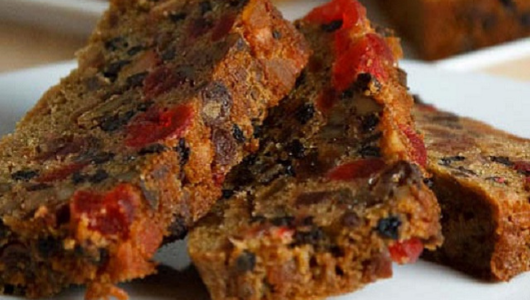
Photo by AÇORES – Quiosques de Turismo
In the Azores, Christmas smells like molasses, dried fruit, spices and citrus zest, brought together in a dense, dark and fragrant cake that is quite old school. Bolo de Natal dos Açores is one of the archipelago’s most cherished holiday traditions.
Unlike the fluffy pão de ló, this Azorean Christmas cake is robust and generous. Its foundation is typically molasses or dark sugar, enriched with butter, eggs and flour, and packed with raisins, nuts, and chopped dried fruits. Spices such as cinnamon, nutmeg, allspice and clove give it a warmth that reflects the islands’ historical connection to maritime trade routes, which brought exotic ingredients to ports like Ponta Delgada, Angra do Heroísmo and Horta.
For a long time, the Azores relied heavily on preservation, since fruit was dried, nuts were stored, and spices were treasured. This dense, durable cake could be made in advance and last through the holiday season. So families would prepare their bolo de Natal days or even weeks before Christmas, allowing it to mature. Similarly to Madeira’s broas de mel, resting the cake deepens the flavors and gives the spices time to meld with the fruit.
Each island, and often each family, has its own variation. Some versions use local liqueurs like aguardente do Pico or sweet wines to moisten the batter, while others add honey, citrus zest or even a touch of cocoa. This Azorean Christmas cake is not at all common elsewhere in Portugal, but we felt it wouldn’t be complete to speak about traditional Portuguese Christmas desserts without also featuring specialities from our archipelagos, which are so often forgotten when we talk about the map of Portugal’s most iconic foods.
You can buy Azorean Christmas cake in Lisbon and carry it back home with you, as it lasts a long time:
Mercearia dos Açores
Thankfully, there are a couple of shops in Lisbon that specialize in products from the Azores islands. This one is one of the most complete and it also sells this spiced fruit cake, which appears as “bolo de fruta de Natal”, available both physically at the store in downtown Lisbon, as well as online for home delivery.
📍Rua da Madalena 115, 1100-318 Lisbon
For more Portuguese festive food stories and holiday inspiration straight from Lisbon, follow Taste of Lisboa on Instagram.
Feed your curiosity on Portuguese food culture:
How to celebrate Christmas like a Portuguese
How to plan and enjoy your Christmas in Lisbon
Alcobaça travel guide for food lovers
Real people, real food. Come with us to where the locals go.
Signup for our natively curated food & cultural experiences.
Follow us for more at Instagram, Twitter e Youtube
